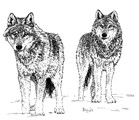Center, Internet, Wildlife Damage Management

Rocky Mountain Wolf Recovery: Annual Reports
Date of this Version
March 2005
Abstract
The gray wolf (Canis lupus) population in the Northern Rocky Mountain (NRM) states (Idaho, Montana, and Wyoming) continued to increase in distribution and abundance (Figure 1, Tables 4a, 4b). Estimates of wolf numbers at the end of 2005 were 565 wolves in the Central Idaho Recovery Area (CID), 325 in the Greater Yellowstone Recovery Area (GYA), and 130 in the Northwest Montana Recovery Area (NWMT) for a total of 1,020 wolves (Figure 1, Table 4a). By state boundaries, there were an estimated 512 wolves in the state of Idaho, 252 in Wyoming and 256 in Montana (Table 4b). Of approximately 134 packs (groups of 2 or more wolves), 71 packs met the definition of “breeding pair,” defined as an adult male and female raising 2 or more pups until December 31 (Tables 4a, 4b). This made 2005 the sixth year in which 30 or more breeding pairs were documented and well distributed within the 3-state area. Biological recovery criteria have been met for removing NRM wolves from the Endangered Species list. No other confirmed wolves or wolf packs were documented in states adjacent to Montana, Idaho and Wyoming in 2005. Wolves in the NRM subsisted mainly on elk, white-tailed deer, mule deer, moose, and bison. Livestock depredations in 2005 included 97 cattle, 244 sheep, 11 dogs and 2 horses that were confirmed as killed by wolves (Tables 5a, 5b). Approximately 36 of 132 known wolf packs (27%) were involved in confirmed livestock depredations. In response, 103 wolves were lethally removed within the 3-state area (about 9% of the 2005 wolf population). No wolves were relocated in 2005. As new packs form within the original core recovery areas and individual animals disperse, the 3 populations increasingly resemble and function as a single, large metapopulation (Figure 1). Numerous research projects are underway, examining wolf population dynamics, predator-prey interactions and livestock depredation.


Comments
This cooperative annual report presents information on the status, distribution and management of the recovering Rocky Mountain wolf population from January 1, 2005 through December 31, 2005. It is also available at http://westerngraywolf.fws.gov/annualreports.htm. U.S. Fish and Wildlife Service, Nez Perce Tribe, National Park Service, and USDA Wildlife Services. 2006 Rocky Mountain Wolf Recovery 2005 Annual Report. T. Meier, ed. USFWS, Ecological Services, 100 N Park, Suite 320, Helena MT. 65 pp.